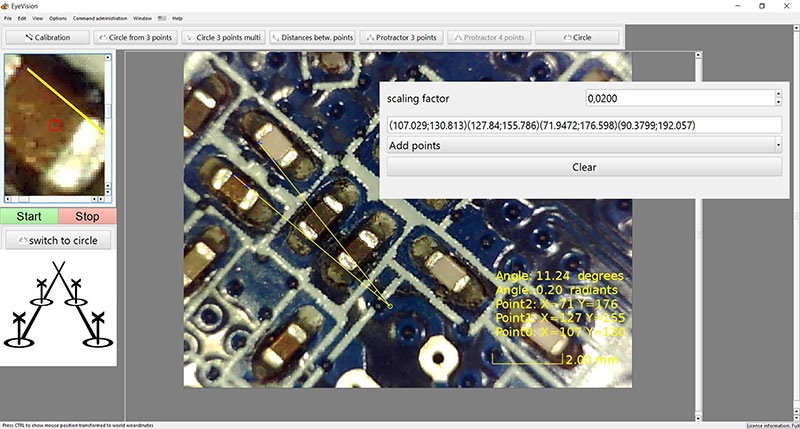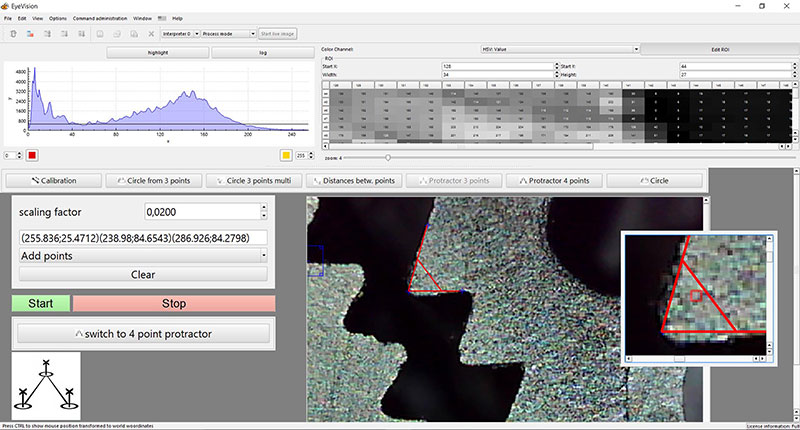 Visit FSI Advanced Research in booth # 2605 at SouthTec 2019 to learn about the latest in machine vision technologies, featuring deep learning and 3D. FSI brings the right technology, engineering expertise and advanced analytics to help clients achieve quality performance and experience greater value. Greenville Convention Center, October 22-24. For more information, click here.
Visit FSI Advanced Research in booth # 2605 at SouthTec 2019 to learn about the latest in machine vision technologies, featuring deep learning and 3D. FSI brings the right technology, engineering expertise and advanced analytics to help clients achieve quality performance and experience greater value. Greenville Convention Center, October 22-24. For more information, click here.
Category Archives: News
FSI Advanced Research will be exhibiting at the South Carolina Automotive Summit

FSI Advanced Research will be exhibiting at the South Carolina Automotive Summit, Feb 19-21, 2019 at the Hyatt Regency, Greenville SC. The SC Automotive Summit is sponsored by the South Carolina Manufacturing Alliance. Click here for more information, or to register.
EyeVision supports DALSA cameras – all at once with Multi-Instance
DALSA Genie camera and many more are now supported by EyeVision
The Genie GigE series and others by DALSA are now supported in EyeVision software.
In addition, EyeVision offers a new feature, where with only one instance several cameras or sensors can be operated at the same time. Computers with more than one core can operate more than one camera per instance. The cameras can run different inspection programs but only use one EyeVision license. In short: One EyeVision license, several instances and several cameras per instance. And it does not matter if the cameras have different interfaces (GigE, USB, RS232, etc.), are 2D or 3D cameras, or have color or grey scale sensors.
 With this function the user might consider using EyeMultiView. It can display up to 16 camera views and evaluation images on one screen. With that many instances and cameras running at the same time, the display functionality of EyeMultiView makes monitoring easier for the user.
With this function the user might consider using EyeMultiView. It can display up to 16 camera views and evaluation images on one screen. With that many instances and cameras running at the same time, the display functionality of EyeMultiView makes monitoring easier for the user.
For example, one camera can run pattern matching for error detection on a label and on the second camera the inspection for closed package. On the third camera the color inspection and the fourth one can read the bar code.  With the Multi-Instance you only need one license for all this. All is now possible with DALSA cameras and as always, the inspection programs can be created with the drag-and-drop function and in the graphical user interface where the user can switch between the different projects and programs.
With the Multi-Instance you only need one license for all this. All is now possible with DALSA cameras and as always, the inspection programs can be created with the drag-and-drop function and in the graphical user interface where the user can switch between the different projects and programs.
EyeSens Robotic for a Robot Vision solution in only a few clicks!
Smart Vision Sensor with commands for robot control
 EVT has now added the new EyeSens Robotic to the Smart Vision Sensor System EyeSens.
EVT has now added the new EyeSens Robotic to the Smart Vision Sensor System EyeSens.
It is now possible to directly control a UR “Universal Robot” with the new software add-on with only a few clicks. With the EyeSens smart vision sensors the user can easily create a complex pick and place application. The Robotic add-on in combination with the EyeSens Match allows every user, beginners as well as advanced users, to solve pick and place applications with a UR robot.
The support of other robots with the EyeSens Vision Sensors will be possible in the near future.
The EyeSens Vision Sensors contain the command set based on EyeVision software which contains hundreds of tools including the KeyMatch (pattern matching) and Blob (object detection) commands.
FSI Advanced Research Exhibiting at SouthTec 2017
 Visit FSI Advanced Research in booth # 214 at SouthTec 2017 to learn about the latest in machine vision technologies, including deep learning, 3D, and multispectral and thermographic imaging. FSI brings the right technology, engineering expertise and advanced analytics to help clients achieve quality performance and experience greater value. TD Convention Center, Greenville, SC, October 24-26. For more information, and to register for free, click here.
Visit FSI Advanced Research in booth # 214 at SouthTec 2017 to learn about the latest in machine vision technologies, including deep learning, 3D, and multispectral and thermographic imaging. FSI brings the right technology, engineering expertise and advanced analytics to help clients achieve quality performance and experience greater value. TD Convention Center, Greenville, SC, October 24-26. For more information, and to register for free, click here.
EyeMeasureEasy
EyeVision software from EVT now offers EyeMeasureEasy (EME), an intuitive image analyzing tool. The user can directly measure and analyze image data with only a few mouse clicks. The tool can be used for applications in microscopy. The features of EME can be extended, so that it can be integrated into a fully automated, industrial inspection process.
With EyeMeasureEasy the user can display live-images, and can save images and load them from memory. There are several different measurement options that can be carried out on those images, such as:
- Angle including three points or four points
- Distances between two points
- Radius of circles including three points or n-points or automatic
The measured results can be shown via a text overlay, list boxes or charts. The measurements can be controlled by the user through “start” and “stop” buttons, or the measurements can be carried out in a free-running measurement.
The camera options can be set directly and the user interface is a design framework for a customized graphic user interface.
EyeVision now supports the Gocator 3D sensor from LMI
 EyeVision software provides the integrated “brain” of the 3D sensor. EyeVision allows the sensor not only to capture an image but also to use the complete 3D command set of the software to measure, compare and read the 3D point cloud or 2D gray-scale image.
EyeVision software provides the integrated “brain” of the 3D sensor. EyeVision allows the sensor not only to capture an image but also to use the complete 3D command set of the software to measure, compare and read the 3D point cloud or 2D gray-scale image.
The Gocator is a compact sensor in an industrial housing with a protection class of up to IP67. It has two digital outputs, RS485 Serial and one analogue output (4 – 20 mA). More than one of the Gocator sensor families can be used with effortless configuration and synchronization.
With the EyeVision machine vision software the sensor has various commands available. Starting with the “3D Blob” command which is very versatile and can be used count objects within a point cloud, the software contains commands to measure openings (holes, slots), cylinder, studs (threaded and non-threaded), plane, etc. It has also 3D volumetric tools: volumes, areas, bounding boxes, positions (min, max, centroid), ellipses, orientations, etc.
Additionally, the 3D-software now also has a “RectProbe” command to find edge-points in a certain direction and returning the detected edge. This can be useful for additional measurements on the point cloud. There are also various filter commands such as “Merge”, which merges two point clouds into one, or the filter command “Outlier Removal”, which removes all points that deviate in Z-direction from their neighbors by a certain amount. Also important is the “Voxelgrid” filter, which down-samples a point cloud using a voxel grid and outputs points that are the average of all points inside a voxel. The filter can make unordered point clouds into ordered.
EyeVision software utilizes a graphical user interface. The commands can be drag-and-dropped in a program editor, where the inspection program can be created, even without programming skills.
FSI Advanced Research Participating in SC Automotive Summit
 FSI Advanced Research will be participating in the 2017 South Carolina Automotive Summit, February 20-22, in downtown Greenville, as part of the South Carolina Auto Week. For more info, click here.
FSI Advanced Research will be participating in the 2017 South Carolina Automotive Summit, February 20-22, in downtown Greenville, as part of the South Carolina Auto Week. For more info, click here.
Automation Technology and FSI at Automate 2017
EyeScan AT 3D with Blue Laser Line
EyeVision software by EVT now also supports a 3D laser triangulation sensor with blue laser. The new EyeScan AT 3D scanner is especially suitable for scanning metal or metallic surfaces.
 Today’s noncontact 3D scanners include one of two laser types: blue laser or red laser. Most 3D scanners, including EyeScan 3D scanners from EVT, user red laser technology. The new EyeScan AT 3D Blue, however, utilizes optically superior blue laser technology.
Today’s noncontact 3D scanners include one of two laser types: blue laser or red laser. Most 3D scanners, including EyeScan 3D scanners from EVT, user red laser technology. The new EyeScan AT 3D Blue, however, utilizes optically superior blue laser technology.
The blue-violet Laser has some clear advantages which provide better scan results. Because it has a shorter wavelength than a red laser, a blue laser delivers improved scanning results with higher resolution and up to a 50-percent reduction in data noise. The shorter wavelength creates a smaller laser speckle pattern, generating a sharper depth image. The blue laser is more effective when scanning metal, because a blue laser is narrower and finer than a red laser line.

Thanks to 20,000 profiles per second and the new blue laser, even complex component parts and surfaces can be captured with high accuracy. The extremely fast scans are possible due to the short exposure time and the preprocessing of data with a FPGA inside the scanner. The high dynamic range algorithm with triple exposure makes it possible for dark and bright objects to be inspected in one scan, without a decrease in speed.




